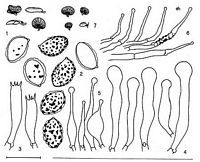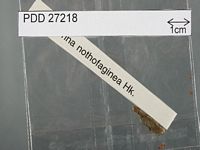|
 Galerina nothofaginea Galerina nothofaginea
BiostatusPresent in region - Indigenous. Endemic
Images (click to enlarge)
Caption: Plate 1. 1-7: Galerina nothofaginea HORAK (1-6: PDD 27218, holotype): 1. habit. - 2.
spores. - 3. basidia. 4, 5. cheilocystidia. - 6. pilocystidia. - (ZT 69/27): 7. habit. | 
Caption: Dried type specimen
Owner: Herb PDD |
Article: Horak, E. (1988) [1987]. On some extraordinary species of Galerina Earle from New Zealand, Australia and Indonesia, with annotations to related South American taxa. Sydowia 40: 65-80.
Description: Pileus -10 mm, circular becoming hemispherical or conchate to kidney-shaped, at first convex
later expanded, margin slightly incurved; argillaceous to cinnamon brown; dry,
membranaceous, conspicuously pruinose to appressed-fibrillose, striate when moist. -
Lamellae (L -6,1-3) adnate to almost free; concolorous with pileus turning (yellow-)brown or
tobacco brown, edge fimbriate to notched, concolorous or white, occasionally with guttation
droplets in young basidiomes. - Stipe -5 x 1 mm, always distinctly developed, cylindrical,
eccentric or lateral, curved; concolorous with pileus; pruinose, solid, single, basal tomentum
none. - Veil remnants absent. - Odour and taste not distinctive.
Spore print rust brown. - Spores 7-9 x 5-6 µm, pip-shaped to subamigdaliform, coarse warts
embedded in conspicuous perispore, supraapicular depression and plage not distinct, germ pore
absent, rust brown. - Basidia 25-35 x 7-8 µm, 4-spored. - Cheilocystidia dimorphic: a) fig. 4: 30-50 x 4-8(-10) µm, broadly fusoid-capitate, with or without strongly refracting plasmatic pigment;
b) fig. 5: 25-50 x 5-8(-3) µm, lecythiform, slender neck with distinct capitate apex, thin-walled,
hyaline. - Pleurocystidia scattered, in size and shape as cheilocystidia. - Caulocystidia numerous,
habit as cheilocystidia (b). - Pileipellis an irregular cutis composed of cylindrical hyphae (5-10 µm
diam.), strongly encrusted with brown pigment, membranes not gelatinized, terminal cells
lecythiform, 30-60 x 1-5 µm, apex 3.5-7 µm diam., numerous, hyaline. - Clamp connections
present.
Habitat: Habitat. - On rotten wood (and bark) of Nothofagus cliffortioides (HOOK. f.) OERST. and N.
fusca (HOOK f.) OERST. (Fagaceae). - New Zealand.
Notes: Remarks. -This species closely resembles Galerina excentrica, the second New Zealand species
with eccentric stipe, by its shape, size and colour of basidiomes. Microscopically G.
nothofaginea is characterized by its rather large, pip-shaped or subamygdaliform spores whose
coarse warts are embedded in a thick (-2 µm diam.) perispore. It is noteworthy that the spores
plage is usually poorly delimited despite the conspicuous perisporial coat. Another remarkable
microscopical feature are the dimorphic cheilocystidia (and pleurocystidia) which are found side
by side both on the edges and to a lesser degree also on the faces of the lamellae. The clavate
cystidia with broadly rounded apices described above under a) are reminiscent of the striking
(cheilo-)cystidia observed in Galerina sect. Physocystis (SMITH & SINGER, 1964). The
cheilocystidia mentioned under b), however, are distinguished by their typical tibiiform shape.
Similar lecythiform cystidia are also observed on the surface of stipe and pileus (pilocystidia).
G. nothofaginea is closely related to the Australian G. tabacina (No. 5) recorded from northern
New South Wales (cf. key). In New Zealand G. nothofaginea occurs on rotten, mossy logs of
Nothofagus (N. cliffortioides, N. fusca). In the field it is readily confused with several taxa of
similar habit and colours which, however, belong to Phaeomarasmius, Flammulaster
(HORAK, 1980 a), Simocybe (HORAK, 1980 b) or Crepidotus.
|